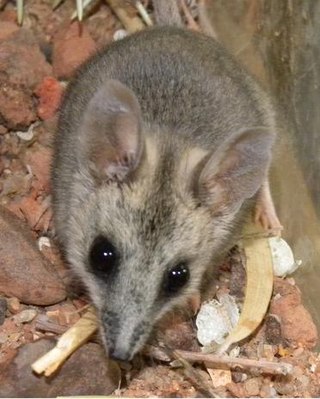
The striped-faced dunnart is a small, Australian, nocturnal, "marsupial mouse," part of the family Dasyuridae. The species' distribution occurs throughout much of inland central and northern Australia, occupying a range of arid and semi-arid habitats.
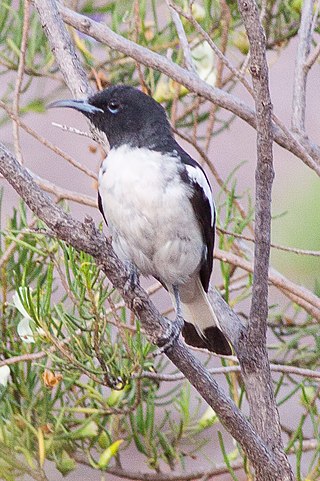
The pied honeyeater is a species of bird in the family of honeyeaters Meliphagidae and the sole species in the genus Certhionyx. This species is also known as the black and white honeyeater or western pied honeyeater.
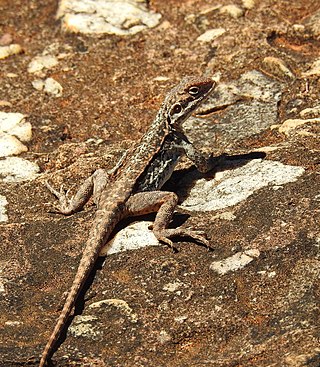
The Barrier Range dragon is an agamid lizard which has been newly described (2013) as a separate species from the tawny dragon. This species is endemic to Australia, restricted to just three sites in western New South Wales (NSW).

The Charcoal Tank Nature Reserve is a protected nature reserve in the central western region of New South Wales, Australia. The 86.4-hectare (213-acre) reserve is situated 10 kilometres (6.2 mi) south of West Wyalong and may be accessed via the Newell Highway and The Charcoal Tank Road. The reserve is an important refuge for native flora and fauna in a highly fragmented landscape, one in which the majority of the original vegetation has been removed.

Lucasium stenodactylum, also known as the crowned gecko or pale-snouted ground gecko, is a species of gecko from Australia.

Ctenotus strauchii, also known commonly as the eastern barred wedge-snout ctenotus or Strauch's ctenotus, is a small species of lizard in the family Scincidae. The species is endemic to Australia and is found throughout semi-arid and arid regions in most of Australia's mainland states except Western Australia, although one record does exist for Western Australia in 1975.

The eastern hooded scaly-foot or eastern scaly-foot is a species of flap-footed lizard found in the complex heaths of the lower west coast and the spinifex grasslands of mainland Australia. They are popular pets and are often mistaken for snakes due to their limbless appearance.
The wood mulch-slider or Mueller's three-toed lerista, is a species of lizard belonging to the extensive family Scincidae, a family containing over 1,500 species. The species is found in a diverse range of climates and habitats throughout Western Australia, Northern Territory, Queensland, New South Wales, South Australia and Victoria. Named after the German-born Australian naturalist Baron Ferdinand Jacob Heinrich Müller (1825–1896), the species has been the subject of much morphological and nomenclature debate.
Ctenophorus mckenziei, more commonly known as the dwarf-bicycle dragon, is a species of endemic Australian lizard within the family Agamidae and genus Ctenophorus. Originally identified as the agamid Amphibolurus mckenziei, the lizard had been identified within the regions of Western Australia and South Australia in which it occupied the shrubbery and woodland areas as its habitat. It was subsequently transferred to the genus Ctenophorus along with other Agamid species in which it shared similar morphology and characteristics. The name mckenziei is in reference to Norman Leslie Mckenzie, who was a zoologist and discovered the existence of the lizard. Listed on the IUCN red list page, threats to its population numbers are evaluated as least concern; however, their numbers are threatened by habitat loss, climate change, and feral predators.

Ctenotus pantherinus, commonly known as the Leopard Ctenotus, is a species of skink endemic to central and western Australia. Its conservation status is currently classified as Least Concern.
The saltbush slender bluetongue is a species of lizard in the family Scincidae. The species is endemic to the arid interior of eastern Australia. Although its conservation status is of least concern, it has been listed as endangered in New South Wales. The slender saltbush bluetongue has been recorded in Sturt National Park in New South Wales but extends into northeast South Australia and south-west Queensland.
Ctenotus atlas, the southern Mallee ctenotus, is a medium sized lizard in the family scincidae (skink) found in the central and southern interior regions of South Australia and Western Australia; the Mallee regions of NSW and Victoria, in Australia.
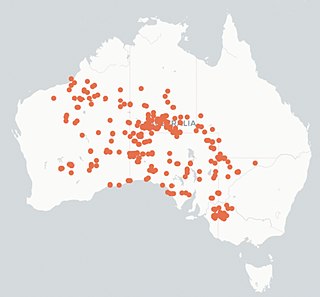
Ctenotus brooksi, also known commonly as Brooks' wedge-snouted ctenotus, the wedgesnout ctenotus, and the sandhill ctenotus, is a species of skink, a lizard in the family Scincidae. The species is endemic to Australia and found in semi-arid regions.
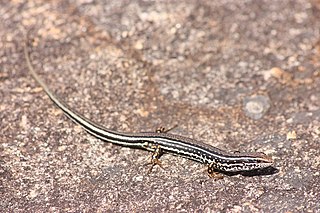
Ctenotus labillardieri, also known commonly as the common south-west ctenotus, Labillardier's ctenotus, and the red-legged ctenotus, is a species of skink, a lizard in the family Scincidae. The species is endemic to the Australian state of Western Australia.

Ctenotus leonhardii, known by the common names Leonhardi's ctenotus, Leonhardi's skink or common desert ctenotus, is a species of skink found in a range of arid and semi-arid regions throughout mainland Australia. The species was named after German anthropologist Moritz von Leonhardi in 1919 and belongs to the genus Ctenotus, one of the largest genera of lizards in Australia.
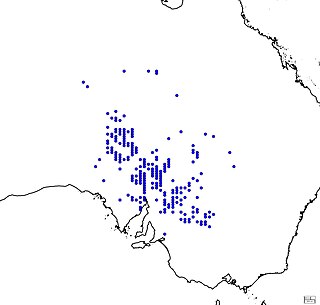
Ctenotus olympicus, the olympic ctenotus, spotted ctenotus or saltbush ctenotus, is a species of skink endemic to the arid shrublands of central and southern Australia.

The pale-rumped ctenotus or regal striped skink is a medium-sized species of skink with an arid distribution restricted to the Australian Mainland, which belongs to the largest group of reptiles in Australia, Ctentotus.

The barred wedge-snout ctenotus is a species of skink found in Australia.[2]
Ctenotus spaldingi is a diurnal terrestrial skink (Scincidae) species of lizard, commonly known as the straight-browed ctenotus or Spalding's ctenotus. Native to Australia the species is found in the northern areas of Australia, along the east coast, in the north and east of South Australia and throughout Victoria and in southern Papua New Guinea. Their conservation status is of least concern classified by the IUCN. Individuals can be up to 30cm long from the snout to tail or 10cm long from the snout to vent (SVL). They typically inhabit grasslands and low vegetation in savannah woodlands in coastal dune areas, monsoon scrub and woodland commonly found around rock outcrops and when disturbed will hide in shallow burrows or amongst ground litter.
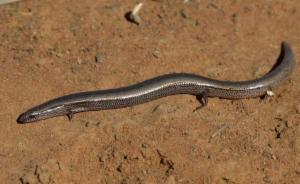
Lerista timida, the dwarf three-toed slider or wood mulch-slider, is a species of skink found in Australia. Other common names for the species include timid slider and dwarf burrowing skink. The skink is a member of the Lerista genus which are confined to continental Australia and are mostly a burrowing species of skink. The genus consists of consists elongated, smooth-scaled, Fossorial lizards that are specialized for life in the upper soils and dry leaf litter through which they slide using Lateral undulation as a form of locomotive action, giving rise to their nickname as sliders. They normally emerge of a night-time to hunt for small Invertebrates such as ants, termites and insects. If disturbed, they dive immediately into any loose substrate to avoid predation, this behavior leaves behind a distinctive disrupted wavy track that often found on sandy flats or dunes, roads and tracks.



















